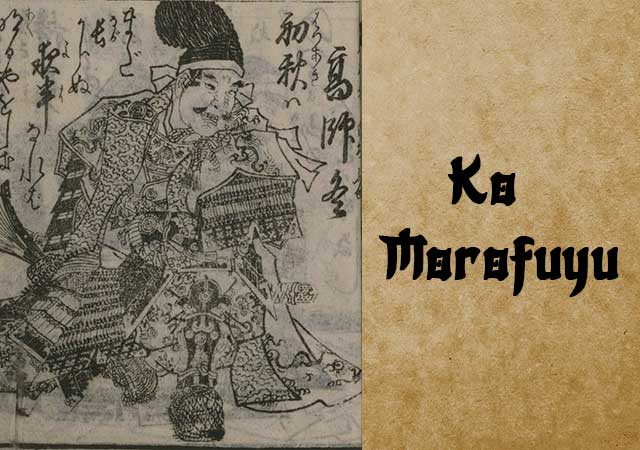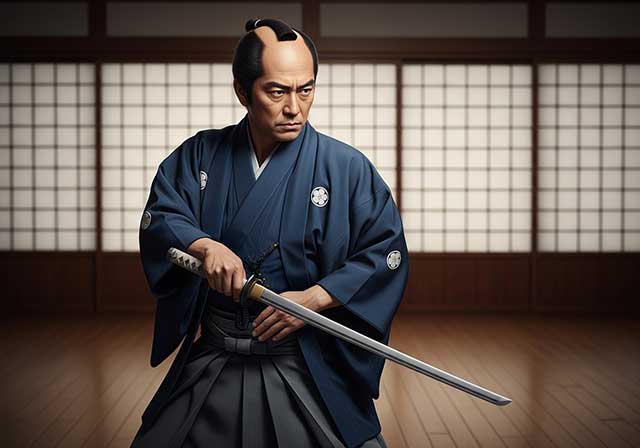
Ko Morofuyu, a key figure in the service of the first Ashikaga Shogun, Ashikaga Takauji, held crucial administrative and military roles in various provinces. Initially serving as the administrative governor of Mikawa Province (Aichi Prefecture) and the military governor of Musashi Province (Saitama Prefecture), he later assumed the governorship of Ise (Mie Prefecture). To ensure clan stability, he was adopted by his cousin, Ko Moronao.
During the Nanboku-cho period, characterized by the division of the Imperial court into Northern and Southern factions, Morofuyu aligned with the Northern court. He actively participated in actions against the court noble Kitabatake Akiie in Aonohara, Mono (Gifu Prefecture) alongside his cousin. In 1339, he became a direct councilor to the Shogun’s son and future shogun Ashikaga Yoshiakira in the Kanto region. His military successes led to his appointment as the Governor of Musashi. Following orders to return to Kyoto, he was later assigned as the governor of Ise, where he continued to distinguish himself in battles.
In 1349, Shogun Ashikaga Takauji sent his fourth son, Motouji, to control the Kanto regions, and Morofuyu, along with Uesugi Noriaki, was tasked with supervision due to Motouji's young age. However, during the subsequent Kanno Joran civil war (1350-1351), when Uesugi and the Shogun's brother defected to the Southern Court ruled by Emperor Go-Daigo, Morofuyu left his post in Kamakura. Engaging in battle with Uesugi Noriaki near Kamakura, Morofuyu suffered defeat. Forced to retreat to Suzawa Castle in Kai Province, he faced encirclement and, on February 13, 1351, chose to perform seppuku.
See also
-
Yagyu Munenori

Yagyū Munenori began his service under Tokugawa Ieyasu while his father, Yagyū Muneyoshi, was still at his side. In 1600, Munenori took part in the decisive Battle of Sekigahara. As early as 1601, he was appointed a kenjutsu instructor to Tokugawa Hidetada, Ieyasu’s son, who later became the second shogun of the Tokugawa clan.
-
Yagyu Muneyoshi

A samurai from Yamato Province, he was born into a family that had been defeated in its struggle against the Tsutsui clan. Muneyoshi first took part in battle at the age of sixteen. Due to circumstances beyond his control, he was forced to enter the service of the Tsutsui house and later served Miyoshi Tōkei. He subsequently came under the command of Matsunaga Hisahide and in time became a vassal first of Oda and later of Toyotomi.
-
Endo Naozune

Naozune served under Azai Nagamasa and was one of the clan’s leading vassals, renowned for his bravery and determination. He accompanied Nagamasa during his first meeting with Oda Nobunaga and at that time asked for permission to kill Nobunaga, fearing him as an extremely dangerous man; however, Nagamasa did not grant this request.
-
Hosokawa Sumimoto

Sumimoto came from the Hosokawa clan: he was the biological son of Hosokawa Yoshiharu and at the same time the adopted son of Hosokawa Masamoto, the heir of Hosokawa Katsumoto, one of the principal instigators of the Ōnin War. Masamoto was homosexual, never married, and had no children of his own. At first he adopted Sumiyuki, a scion of the aristocratic Kujō family, but this choice provoked dissatisfaction and sharp criticism from the senior vassals of the Hosokawa house. As a result, Masamoto changed his decision and proclaimed Sumimoto as his heir, a representative of a collateral branch of the Hosokawa clan that had long been based in Awa Province on the island of Shikoku. Almost immediately after this, the boy became entangled in a complex and bitter web of political intrigue.
-
Honda Masanobu

Masanobu initially belonged to the retinue of Tokugawa Ieyasu, but later entered the service of Sakai Shōgen, a daimyo and priest from Ueno. This shift automatically made him an enemy of Ieyasu, who was engaged in conflict with the Ikkō-ikki movement in Mikawa Province. After the Ikkō-ikki were defeated in 1564, Masanobu was forced to flee, but in time he returned and once again entered Ieyasu’s service. He did not gain fame as a military commander due to a wound sustained in his youth; nevertheless, over the following fifty years he consistently remained loyal to Ieyasu.
-
Honda Masazumi

Masazumi was the eldest son of Honda Masanobu. From a young age, he served Tokugawa Ieyasu alongside his father, taking part in the affairs of the Tokugawa house and gradually gaining experience in both military and administrative matters. At the decisive Battle of Sekigahara in 1600, Masazumi was part of the core Tokugawa forces, a clear sign of the high level of trust Ieyasu placed in him. After the campaign ended, he was given a highly sensitive assignment—serving in the guard of the defeated Ishida Mitsunari, one of Tokugawa’s principal enemies—an obligation that required exceptional reliability and caution.
-
Hojo Shigetoki

Hōjō Shigetoki, the third son of Hōjō Yoshitoki, was still very young—only five years old—when his grandfather Tokimasa became the first member of the Hōjō clan to assume the position of shogunal regent.
-
Hojo Masako

Masako was one of the most influential and powerful political figures of the era of military rule in Japan. She was the daughter of Hōjō Tokimasa and the wife of Minamoto no Yoritomo.

